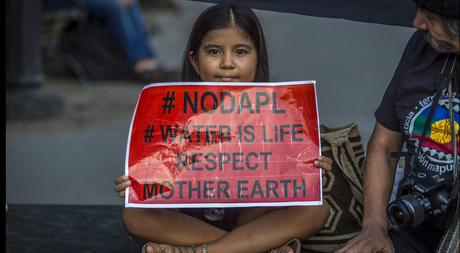
#NoDAPL
For the past couple of months, I have watched with empathy and solidarity as a great number of Native Americans have been camping out on the Standing Rock Sioux reservation in North Dakota. They have been protesting the construction of a crude oil pipeline called the “Dakota Access pipeline,” which endangers their community. While these protests have been peaceful, protesters faced increasingly violent responses over the past few months. But it seems their hard work has paid off: The Department of Justice, the Department of the Army, and the Department of the Interior just put a temporary ban on the construction of the pipeline. In reality, however, the battle is a long way from being done.
There are two main issues protesters have taken with the construction of the Dakota Access Pipeline. First, the proposed pipeline would cross the Missouri River about a half-mile from the Sioux Tribe reservation boundary. This would put the reservation in close proximity to a potential oil spill, which could contaminate drinking water for thousands. Those concerns are backed by data from 2012 to 2013, which indicated there were 300 oil pipeline breaks across North Dakota — information which has led many to believe that an oil leak is inevitable.
Contaminated drinking water endangers both the health of any effected community and creates additional economic burdens on affected families by forcing them to rely on expensive alternatives in case of a spill. A lack of clean water would also intensify the economic disparity Native American women face, as they already have the second largest wage gap of any racial group. As far as health is concerned, chemicals present in oil obtained from fracking (known carcinogens) put women and their babies at risk of premature births and high-risk pregnancies. The devastating effects of the water crisis in Flint should have taught us that we can’t continue to allow families to be poisoned for profit.
The second main issue is that the pipeline would tread through and destroy sights the Sioux Tribe consider historically and religiously significant. Many have already been destroyed or damaged by the construction. One such sight is the Strong Heart Society Staff, where a sacred rattle or staff was placed within stone rings. Here members of the elite warrior society would come to make pledges and the area is considered tangible evidence that Strong Heart members followed a “spiritual path.”
It is also important to acknowledge and place this situation in the context of a long history of this nation exploiting and violently displacing Native American communities for economic gain. The Dakota pipeline is yet another chapter in the long history of oppression Native American communities have face — and particularly women within those communities. In the 1800s, this oppression was evident in the U.S. government’s decision to force Native children to attend boarding schools that taught white supremacy. In the 1970s it manifested itself in the governmental subjugating of forced sterilization of Native Women. And today, this legacy is clear in the statistics that show that Native American women are almost three times more likely than other groups to be sexually assaulted – with two-thirds of those assaults being committed by non-Natives. This is certainly connected to the DAPL: Many projects in the past, including the Bakken Oil patch and the Belo Monte dam in Brazil and now North Dakota, have shown that development projects on Native land can and does lead to an increase of violence against Native American women and threatens and further suppresses their communities.
The Dakota Access Pipeline, therefore, has clear economic, environmental, and health consequences for the Native community. Youth activists in this community have particularly pushed for and achieved significant change: Sioux Youth at Standing Rock’s collection of letters about the importance of water and the fundamental human right to it, for example, are immensely powerful and inspiring. Their work has undeniably contributed to the nationwide conversation that prompted the recent halt of the pipeline’s construction.
But while the U.S. Army Corps of Engineers said Sunday that it won’t grant an easement for the Dakota Access oil pipeline in southern North Dakota — which was considered a major victory for the Standing Rock Sioux tribe and its supporters — it appears Energy Transfer Partners, the company that is building the pipeline, will still try to build the pipeline under the river nonetheless. Now more than ever, therefore, it’s crucial to stand with Standing Rock — now and forever.

